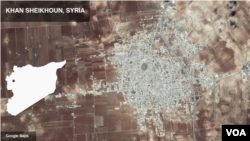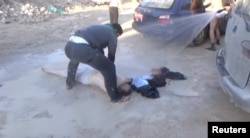Monitors and civil defense workers alleged Tuesday that Syrian government or Russian warplanes carried out a toxic gas attack on a rebel-held town in northern Syria, killing dozens of people and injuring hundreds more.
The Union of Medical Care and Relief Organizations, a coalition of Western humanitarian and medical organizations, put the death toll at 100 with more than 350 injured.
Syrian opposition activists described the attack as among the worst in the country's brutal six-year civil war and the main political opposition group, the Syrian National Coalition, dubbed it a “horrifying massacre.”
Russia has "categorically denied" any role in the attack. Syria's government denied using chemical weapons against civilians.
The U.N. Security Council will hold an emergency meeting discuss the incident on Wednesday morning.
The Idlib Media Center of pro-opposition activists and rescue workers known as the White Helmets posted video footage and still photographs of the aftermath of the airstrike on the town of Khan Sheikhoun.
The footage appeared to show a young girl hooked up to a ventilator and the bodies of several children being covered with a blanket.
In other videos, medics can be be seen trying to resuscitate a small girl and assisting adults struggling with breathing difficulties. One picture showed rescue workers placing the body of a man into the back of a truck.
Locals say they expect the death toll to rise.
People choked, vomited or fainted minutes after the attack, reported the Syrian Observatory for Human Rights, a London-based monitoring group that gathers information from activists on the ground. The group said it had received initial reports of the attack from medics in the town.
The Observatory said at least 11 children are among the dead.
The French news agency (AFP) later reported from one of its journalists in Khan Sheikhoun that a missile slammed into a hospital where some of the victims were being treated, bringing rubble down on medics as they struggled to treat victims.
US reacts
In Washington, White House spokesman Sean Spicer condemned the "intolerable attack" and said the U.S. holds the regime of Syrian President Bashar al-Assad responsible. He also said the "heinous actions" of the regime were the result of "weakness" by the previous administration of Barack Obama.
The attack, which caught many of the town’s residents sleeping in their beds, came on the eve of a major international meeting in Brussels on the future of Syria hosted by the European Union’s chief foreign affairs official, Federica Mogherini.
The Assad government has repeatedly denied that its warplanes carry out raids with chemical weapons. Last week, officials in the Syrian capital dismissed all such allegations as “devoid of truth.”
Government-owned media outlets suggested Tuesday that the airstrike may have hit a rebel chemical weapons factory or stockpile.
The Syrian National Coalition called Tuesday for an emergency session of the United Nations Security Council, blaming the airstrikes on the “regime of the criminal Bashar.” In a statement, it said government warplanes fired missiles carrying poisonous gas.
The coalition urged U.N. officials to "open an immediate investigation" and take the necessary measures to ensure the officials, perpetrators and supporters are held accountable.
The reported attack on Khan Sheikhoun to the west of Aleppo and south of the city of Idlib, the provincial capital, is the third claimed chemical weapons attack in just over a week in Syria. Another two blamed on the Syrian government were reported in Hama province, not far from Khan Sheikhoun.
Chemicals used
What chemical agent was used is not clear, but some opposition websites said highly toxic sarin gas may have been employed. Some medics working on the victims also pointed to sarin as the agent most likely used.
“We have no doubt that this is a sarin attack,” said Dr. Shajul Islam, a British medic working in a clinic, which received three of the victims. He posted a video on Twitter showing the victims with pinpoint pupils, which were unresponsive when light was shone on their eyes.
Omer Idlibi, a member of the opposition group Syria Revolutionaries, told VOA's Kurdish service "all the symptoms from the victims point to sarin gas.” "The medical situation is very bad, due to the lack of hospitals and because the regime targeted all the field hospitals used for treating victims," he added.
A U.N. investigation found credible evidence that sarin was used in August 2013 attack on the Damascus suburb of Ghouta that killed hundreds of civilians. In most alleged chemical weapons attacks since then, the agent thought to be used most often has been chlorine.
Rebel groups have also been accused in the past of using chlorine in rocket attacks, and the Islamic State terror group has been blamed for a mustard gas attack in Syria.
British medical expert David Nott told Britain’s Sky News he was unsure whether the agent used was chlorine or sarin but said if the latter, he would expect the death toll to climb rapidly.
New York-based Human Rights Watch accused the Syrian government of mounting eight chlorine gas attacks on insurgent-controlled areas during the final weeks of the battle for Aleppo last year.
A joint investigation by the United Nations and the international chemical weapons watchdog blamed the Syrian government for at least three attacks in 2014 and 2015 involving chlorine gas.
Rebel groups walked out of Russian-brokered peace talks in Astana, Kazakhstan earlier this month in protest at what they said were ongoing violations of a cease-fire.
Idlib province is one of the last redoubts of anti-Assad rebels and the United Nations estimates there are nearly a million displaced Syrians in the province, many from Aleppo.








